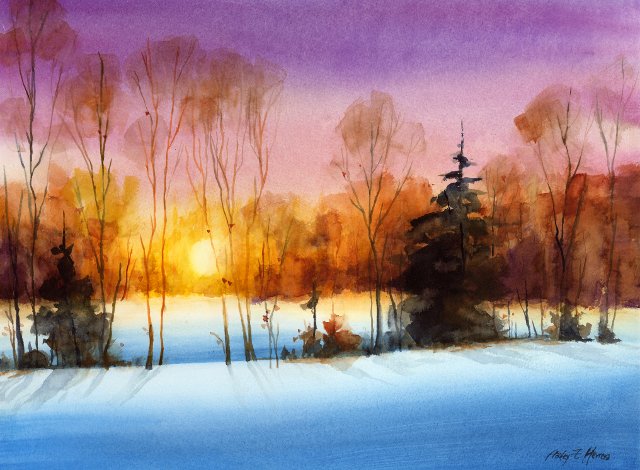How to Create Stunning Watercolor Paintings Doing a Watercolor Class Online: Tips and Techniques from the Masters

Watercolor painting is a beautiful and rewarding art form that requires a basic understanding of its materials, color theory, and techniques.
When starting with watercolor painting, it is essential to choose the right materials, including high-quality watercolor paints, brushes, and paper, to achieve the desired results.
Keep in mind that no technique or tool is better than another, and each has an appropriate use. Therefore, it is crucial to experiment with different approaches and materials to discover what works best for you.
Understanding color theory is also an essential aspect of watercolor painting. The color wheel, cool/warm colors, analogous colors, and more are all part of color theory and can significantly impact the final outcome of a painting
Professional artist Jill Poyerd suggests taking a thorough, well-rounded approach to color theory, starting with the science and history of color and then guiding students through practical applications. By understanding color theory, artists can create more cohesive and visually appealing paintings.
Learning basic techniques is crucial to creating stunning watercolor paintings. Techniques such as wet-on-dry, wet-on-wet, and glazing are fundamental skills that every beginner should master. Additionally, it is essential to use enough water to create the desired effect while also being careful not to drop water unless intending to create water blooms with hard edges.
With practice and experimentation, artists can develop their own unique style and create stunning works of art in watercolor.
Techniques for creating stunning watercolor paintings
One of the most popular techniques for creating stunning watercolor paintings is the wet-on-wet technique. This involves applying wet paint onto wet paper, allowing for soft, blended washes and beautiful gradients.
To achieve the best results with this technique, it’s important to use medium to heavier-weight paper with enough tooth/absorbency and to give the paper enough time to absorb the water before applying the paint. This technique is versatile and can be used to create a wide range of effects, from delicate florals to bold landscapes.
Another popular technique is the dry brush technique. This involves loading your brush with paint and applying it onto dry paper, creating hard edges that can be softened immediately. Brushing lightly with a damp brush can also help to glaze layers and create a variety of textures. This technique is ideal for creating detailed and precise paintings, such as botanical illustrations.
Lifting and layering techniques can also be used to create stunning watercolor paintings. Lifting involves removing paint from the paper with a damp brush or sponge, creating highlights and adding depth to the painting.
Layering involves building up colors and details gradually, paying attention to light and shadow, and using a combination of wet-on-wet and wet-on-dry techniques to achieve the desired effect. Scumbling is another layering technique that involves applying light colors on top of darker colors to create a textured effect.
Glazing is also a popular layering technique that involves applying thin, transparent layers of paint to create luminosity and depth. By mastering these techniques, artists can create stunning watercolor paintings that are full of depth, texture, and beauty.
Tips for mastering watercolor painting
Watercolor painting can be a challenging medium to master, but with practice and with quality watercolor classes online, it is possible to create stunning works of art. One of the most important tips for mastering watercolor painting is to practice consistently. This allows you to develop your skills and techniques over time and to gain a better understanding of how to work with the medium.
Additionally, experimenting with different techniques and styles can help you discover your own unique artistic voice. By practicing regularly, doing regular online watercolor classes, and trying new things, you can improve your watercolor painting skills and create beautiful works of art.
Another important aspect of mastering watercolor painting is to not be afraid of making mistakes. Mistakes are a natural part of the learning process and can provide valuable opportunities for growth and improvement. By learning from your mistakes, you can refine your techniques and develop a better understanding of how to work with the medium.
Additionally, exploring the techniques and styles of watercolor painting masters can provide inspiration and guidance. By studying the work of successful artists, you can gain insights into their techniques and approaches to the medium.
Finally, it is important to experiment with different watercolor painting techniques to create stunning works of art. For example, using the wet-on-wet technique can create beautiful blended washes and gradients.
Scratching, salt sprinkling, and using different brushes can add texture and interest to your paintings. Additionally, mixing colors to achieve desired shades and tones can help create depth and dimension in your work. By exploring different techniques and styles, you can create unique and stunning watercolor paintings.
In conclusion, creating stunning watercolor paintings requires a basic understanding of the materials, color theory, and techniques. By choosing the right materials, learning basic techniques, and experimenting with different styles, anyone can master the art of watercolor painting.
Additionally, practicing regularly and not being afraid to make mistakes and learn from them are essential tips for improving one’s skills. With dedication and patience, anyone can create beautiful watercolor paintings like the masters.


Responses